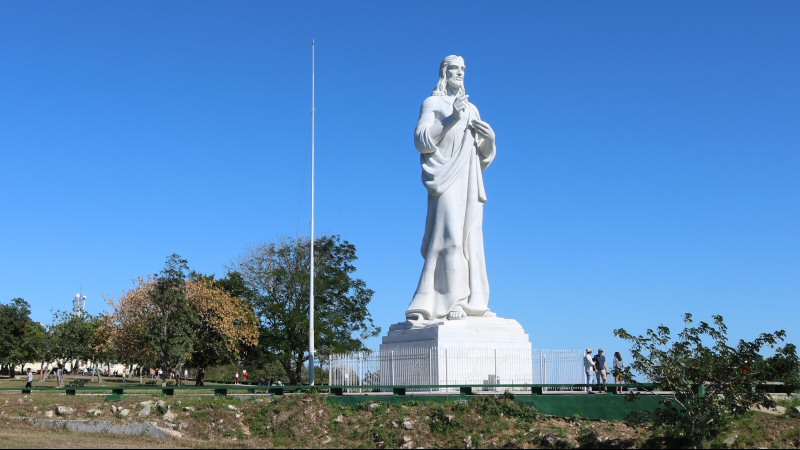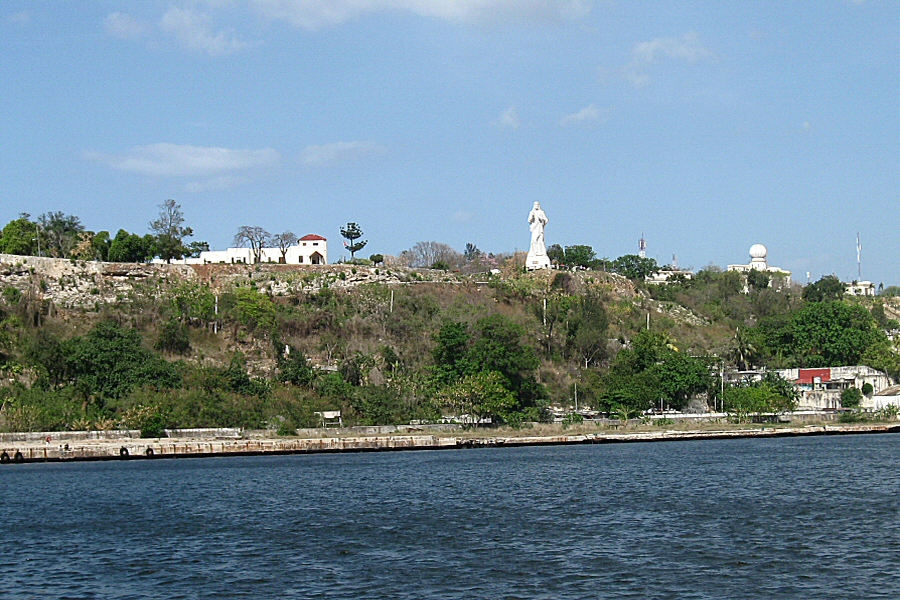
The Cristo de la Habana is located on a
hilltop, called Cabaña, on the north side of the entrance
channel of the bay of Havana (Bahía de la Habana), where the
channel opens to the bay, between the Fortelaza de San Carlos de
Cabaña and the neighborhood Casablanca.

During the assault on the Presidential
Palace in 1957 to execute the bloody dictator Fulgencio Batista,
his wife Marta Fernández Miranda (1923-2006) promised in
desperation to erect a statue of Christ
that could be seen from any corner of the city, if
her husband would be able to survive the attack remaining alive.
The same day the attack was repulsed, and Batista could continue
with his presidency. Thus, the first lady launched a campaign to
raise funds that were necessary to keep her promise. Finally,
she could collect about 200.000 pesos. The unpretending sketch
of the Cuban artist Jilma Madera won the contest.
Jilma Madera explained her feelings in
sculpting the statue of Christ later by these words: ‘‘I had
built the figure of Christ, the man, but not the mystic one of
Catholicism…although I have never professed the catholic
religion; I have always admitted to be a Christian, but if
people were truly Christian, I am sure everything would be
better’’.
The board members that coordinated the
project, had contradicting ideas about the height of the statue.
Some were standing up for the height of 35 meters, a height that
was three meters more than the height of the famous Cristo
Redentor (Christ the Redeemer) in Rio de Janeiro, Brazil.
Finally, upon the strong opposition of Jilma Madera, they agreed
in the height of 20 meters, as a higher statue would not look
good like the Cristo Redentor that was erected on the summit of
Corcovado that was 710 meters high above the see level.
Jilma Madera went to Italy to prepare
the pieces of the marble statue that would be assembled later in
Havana. The marble blocks were extracted from the Apuanos Alps
close to Carrera. Each piece was sculptured by her in Rome
later. She had sculpted a plaster model of three meters high for
this purpose. She stayed for more than one year in Italy to
oversee every detail of the construction process and to direct
the workers.
Jilma held herself very responsible of
the artistic work. She paid for the marble blocks out her own
pocket, with the prize money she had won. She bore even the cost
of her travel to Italy, and paid insurance for each of the
marble blocks for her own. She did not forget also to receive
the blessing of Pope Pius XII for each block of marble. Finally,
all marble pieces, protected in wooden crates, were shipped from
the port of Marina in Carrera, Italy in 1958.
The process of assembling the pieces of
the marble statue began with a manpower of 17 men and a crane.
First a deep hole was dug, wide enough to accommodate the base
of the statue. A steel frame with a central steel beam was
inserted on the base, as high as the head of the statue. Each
part of the statue was tied to the central structure by steel
wires and screw shackles and the empty space inside of the
statue was filled with concrete after being sure that each level
of the statue was aligned correctly.
The assembly of the statue completed in
3 months and the colossal statue was unveiled by the President
Fulgencio Batista on December 25, 1958, on Christmas Day, when
the Catholic World commemorates the birth of Jesus Christ. The
statue was blessed by Cardinal Manuel Arteaga Betancourt,
however against his will, because he had a bad relationship with
the dictator Fulgencio Batista. The First Lady couldn’t share
her happiness with other people sufficiently, as she had to rush
with Fulgencio Batista to Dominican Republic in the early hours
of January 1, 1959 due to the irrepressible advance of the Rebel
Army to Havana.
In 1961 the pylon that was used to
lighten the area around the statue, was toppled by a strong wind
and pierced the back of the head of the statue. Jilma was afraid
that the rain water would penetrate the statue and corrode the
steel framework. Fortunately, she had brought
an additional block of marble with her from
Italy. The repair, directed by Jilma herself,
lasted for five months. The same mishap occurred the following
year again. The statue was restored for the second time in
1980s, but the restoration was guided by different institutions
that did not take the technical details so much into account and
did not beware of using incompatible material.
In 2012, it became necessary to carry out
a through restoration of the marble statue, as its entire
surface was covered with salt deposits and reddish stains, and
it occurred large gaps in the mortar between the marble blocks,
particularly in the elbow, the folds of
the clothes and the face of the statue. Additionally, the head
and the right elbow of the statue had been damaged physically by
the pylon that was used to lighten the area, again
in 1986. The collapse of the statue by an
earthquake or strong wind was not very unlikely. A board, headed
by the chemical engineer Carlos Bauta, was commissioned to carry
out the restoration. The investor Oficina del
Historiador de La Habana (Office
of the Historian of the City of Havana was represented by the
architect Nitzy García in the board. The multidisciplinary team
that was responsible for the restoration process, received the
National Restoration Award 2013, as it succeeded in fullfilling
the multiple and complex technical and artistic tasks
excellently. The statue was declared National Monument in 2017.
 The majestic marble statue is placed on
the hilltop overlooking the Bay of Havana. Except the pedestal
that is 3 meters (10 feet) high, the statue has a height of 20
meters (66 feet). The statue is erected on a platform that is 51
meters (167 feet) high above the sea level.
The majestic marble statue is placed on
the hilltop overlooking the Bay of Havana. Except the pedestal
that is 3 meters (10 feet) high, the statue has a height of 20
meters (66 feet). The statue is erected on a platform that is 51
meters (167 feet) high above the sea level.
During its construction 600, tons of
white Carrera marble were used, and when it was assembled
together, its weight reached about 320 tons. The statue is
consisting of 670 pieces, aligned in 12 horizontal levels.
The huge Christ statue can be seen from
diverse points of the city, not only because of its great
dimensions, but also because of the contrast between the white
marble statue and the gray rocks around it. Jesus of Nazareth
is represented standing and looking towards the city. With the
left hand near to his chest, he holds his right hand high in an
attitude of blessing.
Jim
Madera did not use any model to sculpt it, but she was
succssfull to reflect the ideal masculine beauty in her mind by
sculpting oblique eyes and voluminous
lips. Maybe she wanted to refer to the racial
miscegenation of the island. However, there
is a general belief that Jilma Madera did not took any prototype
of a man as model, but maybe she was inspired by a special man with
whom she was sentimentally linked.
The eyes of the statue were
left empty peculiarly to give the impression, as if he looks at
everybody from all angles. The statue wears flip-flops like
Jilma. Some objects were buried by Jilma under the base of the
monument, such as newspapers and coins. In contrary to its peers
in Brazil, Bolivia, Portugal and Angola, the statue doesn’t
welcome people with open arms. Like the Virgen de la Caridad del
Cobre, the Christ of Havana has a cultural value more than its
religious one. During the unveiling ceremony of the statue, Jima
Madera laid emphasize on this subject: “I made it
to be remembered and not to be worshiped, as it is made of
marble.” In other words, the
visitors of the artwork of Jilma Madera don’t go to there to
worhip Jesus Christ, but rather to enjoy the spectacular view of
Havana. From the panaromic viewpoint at the site of the statue,
you can enjoy one of the most beautiful and impressive views,
particularly of Old Havana. On the other hand, the best view of
the statue is from the Old City, particularly in the evening
when it is floodlit.
It is a peaceful place. Some
locals sit and drink beer or fresh coconut juice, some
talk.
